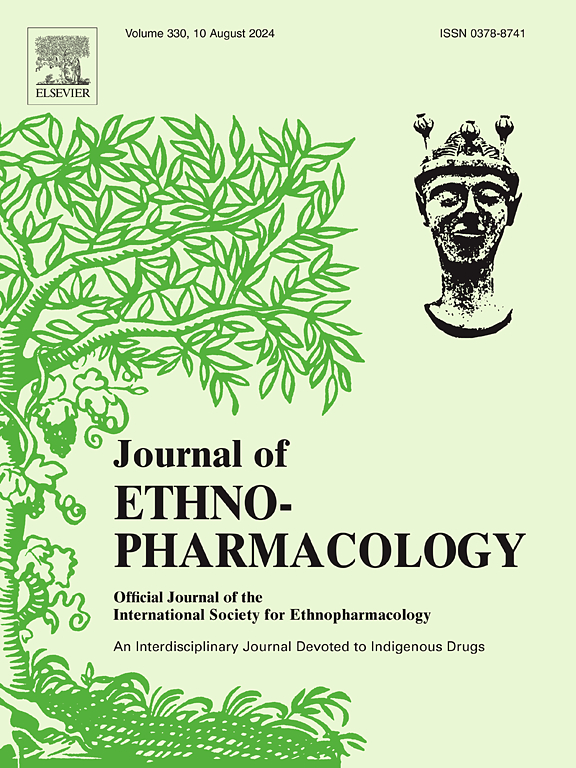Integrative pharmacological analysis of modified Zuojin formula: Inhibiting the HIF-1α-mediated glycolytic pathway in chronic atrophic gastritis
IF 4.8
2区 医学
Q1 CHEMISTRY, MEDICINAL
引用次数: 0
Abstract
Ethnopharmacological relevance
Zuojin formula (ZJF) is a well-known herbal medicine in Pharmacopoeia of China, which is widely used for gastritis. Modified Zuojin formula (MZJF) was adapted based on traditional Chinese medicine (TCM) theories concerning gastric atrophy and dysplasia, along with extensive clinical experience, has been clinically employed to treat chronic atrophic gastritis (CAG). However, the underlying mechanisms by which MZJF intervenes in CAG remain to be fully elucidated.
Aim of the study
The aim of this study was to evaluate the effects of MZJF intervention in CAG and explore its potential mechanisms.
Methods
Four induction factors were used to establish a CAG rat model. HE and AB-PAS staining was utilized to assess the effects of MZJF in the intervention of CAG. The stomach weight index and gastric acid pH was used to assess the overall state of stomach. ELISA was used to assess the gastric mucosal inflammatory response. Using transmission electron microscopy to observe chief cells and parietal cells, we evaluated the improvement of ultrastructure by MZJF. Through network pharmacology analysis, the possible regulatory mechanism of MZJF in CAG was preliminarily explored. Binding interactions between MZJF components and predicted targets were explored using molecular docking. Subsequently, quantitative real-time PCR (qRT-PCR), Western blot, biochemical analysis and TUNEL staining were applied to validate the effect of MZJF on predicted pathway.
Results
MZJF treatment ameliorated gastric mucosal pathology, inflammation, cellular ultrastructural damage and PG levels, halted the exacerbation of CAG in rats, along with a reduction in stomach weight index and gastric acid pH. A total of 79 compounds in MZJF targeting 203 CAG-related molecules were identified through network pharmacology. Enrichment analysis of the core targets was focused on the hypoxia inducible factor-1α (HIF-1α) signaling pathway. Molecular docking results identified HIF-1α as stable binding targets for MZJF primary components. Subsequently, PCR, WB, and biochemical results showed that MZJF suppressed the gene and protein expression levels of HIF-1α and its downstream molecules including glycolytic enzymes and transporters, modulated glucose, pyruvic acid and lactate levels in gastric mucosal tissue. Moreover, MZJF induced apoptosis of gastric epithelial cells, as evidenced by the upregulation of cleaved caspase-3, Bax, Bax/Bcl-2 and TUNEL positive cells ratio.
Conclusions
MZJF suppressed the HIF-1α-mediated glycolytic pathway, and promoted cell apoptosis, thereby halting the malignant transformation of CAG. The study provides a valuable reference point for applying TCM in preventing and treating CAG.

改良左金方的综合药理分析:抑制 HIF-1α 介导的慢性萎缩性胃炎糖酵解途径
民族药理学意义:左金方(ZJF)是《中国药典》中的名贵中药材,广泛用于治疗胃炎。改良左金方(MZJF)是根据中医关于胃萎缩和胃发育不良的理论,结合丰富的临床经验改良而成,已被临床用于治疗慢性萎缩性胃炎(CAG)。然而,MZJF干预CAG的内在机制仍有待全面阐明:本研究旨在评估MZJF干预CAG的效果并探索其潜在机制:方法:使用四种诱导因子建立 CAG 大鼠模型。HE和AB-PAS染色评估MZJF干预CAG的效果。用胃重量指数和胃酸 pH 值评估胃的整体状态。ELISA 用于评估胃粘膜炎症反应。通过透射电子显微镜观察主细胞和顶细胞,评估MZJF对超微结构的改善作用。通过网络药理学分析,初步探讨了MZJF在CAG中可能的调控机制。利用分子对接法探讨了MZJF成分与预测靶点之间的结合相互作用。随后,应用定量实时PCR(qRT-PCR)、Western印迹、生化分析和TUNEL染色等方法验证了MZJF对预测通路的影响:结果:MZJF治疗可改善大鼠胃黏膜病理、炎症、细胞超微结构损伤和PG水平,阻止CAG恶化,同时降低胃重量指数和胃酸pH值。通过网络药理学,MZJF 中共有 79 个化合物靶向 203 个 CAG 相关分子。核心靶点的富集分析主要集中在缺氧诱导因子-1α(HIF-1α)信号通路上。分子对接结果表明,HIF-1α 是 MZJF 主要成分的稳定结合靶标。随后,PCR、WB和生化结果表明,MZJF抑制了HIF-1α及其下游分子(包括糖酵解酶和转运体)的基因和蛋白表达水平,调节了胃黏膜组织中葡萄糖、丙酮酸和乳酸的水平。此外,MZJF 还能诱导胃上皮细胞凋亡,表现为上调裂解的 caspase-3、Bax、Bax/Bcl-2 和 TUNEL 阳性细胞比率:结论:MZJF能抑制HIF-1α介导的糖酵解通路,促进细胞凋亡,从而阻止CAG的恶性转化。该研究为应用中医药防治CAG提供了有价值的参考。
本文章由计算机程序翻译,如有差异,请以英文原文为准。
求助全文
约1分钟内获得全文
求助全文
来源期刊

Journal of ethnopharmacology
医学-全科医学与补充医学
CiteScore
10.30
自引率
5.60%
发文量
967
审稿时长
77 days
期刊介绍:
The Journal of Ethnopharmacology is dedicated to the exchange of information and understandings about people''s use of plants, fungi, animals, microorganisms and minerals and their biological and pharmacological effects based on the principles established through international conventions. Early people confronted with illness and disease, discovered a wealth of useful therapeutic agents in the plant and animal kingdoms. The empirical knowledge of these medicinal substances and their toxic potential was passed on by oral tradition and sometimes recorded in herbals and other texts on materia medica. Many valuable drugs of today (e.g., atropine, ephedrine, tubocurarine, digoxin, reserpine) came into use through the study of indigenous remedies. Chemists continue to use plant-derived drugs (e.g., morphine, taxol, physostigmine, quinidine, emetine) as prototypes in their attempts to develop more effective and less toxic medicinals.
 求助内容:
求助内容: 应助结果提醒方式:
应助结果提醒方式:


